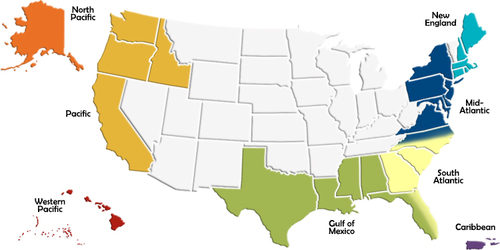Seafood Safety Training Resources
- Seafood HACCP Guidance & Regulations
- NOAA Fisheries
- Food Safety
- Food Defense
Seafood HACCP Guidance
U.S. Food and Drug Aministration (FDA) - Seafood HACCP Guidance
- FDA - Seafood Hazard Analysis Critical Control Point (HACCP) Regulation (21 CFR Part 123)
- FDA - Good Manufacturing Practices (21 CFR Part 110)
- FDA - Seafood Guidance Documents & Regulatory Information
- FDA - Fish and Fishery Products Hazards and Controls Guidance (Webpage)
- Fish and Fishery Products Hazards and Controls Guidance (PDF)
- Fish and Fishery Products Hazards and Controls Guidance (Spanish-language translation) Orientación de controles y peligros de los productos pesqueros y piscícolas (PDF)
- FDA - National Shellfish Sanitation Program (NSSP) - Guide for the Control of Molluscan Shellfish
- FDA - Interstate Certified Shellfish Shippers List (ICSSL) - Updated Monthly List
- FDA - The Seafood List: The Seafood List is FDA's Guide to Acceptable Market Names for Seafood sold in Interstate Commerce. It is available as a searchable database.
Seafood Network Information Center (NIC), Oregon State University
One of the world's first seafood technology network information centers, SeafoodNIC is a portal to Internet resources addressing seafood safety and quality information needs of seafood processors, inspectors, researchers, importers, and food educators.
Seafood HACCP
DHHS. Food and Drug Administration. Contains regulation on Seafood HACCP. Also includes evaluations, and information from other sources.
Oregon State University. Seafood Network Information Center. A detailed compendium sectioned into seafood processes and biological, chemical, and physical hazards and controls.
Seafood HACCPOregon State University. Seafood Network Information Center. Compilation of numerous resources including FDA's hazards & controls guide, HACCP training schedules, generic HACCP forms and plans, regulation, and more.
Seafood: Guidance for IndustryDHHS. Food and Drug Administration. Contains guidance documents related to HACCP regulations and compliance.
Fish and Fishery Products Hazards and Controls Guidance, 4th editionDHHS. FDA. Center for Food Safety and Applied Nutrition. This guidance is intended to assist processors of fish and fishery products in the development of their Hazard Analysis Critical Control Point (HACCP) plans. Processors of fish and fishery products will find information in this guidance that will help them identify hazards that are associated with their products, and help them formulate control strategies.
Seafood HACCPAssociation of Food and Drug Officials. Links to HACCP training resources. Includes course registration information and introduces the Seafood HACCP Alliance and AFDO Seafood HACCP.
HACCP Course PowerPoint Slides (ZIP | 839 KB)National Seafood HACCP Alliance for Training and Education. Introductory HACCP PowerPoint slides for training/educational purposes.
Seafood Safety - Economics of Hazard Analysis and Critical Control Points (HACCP) ProgrammesFood and Agriculture Organization. Technical paper describing the effect of Seafood HACCP on food safety, international trade, and priorities for the future.
NOAA HACCP Quality Management Program Requirements (PDF | 141 KB)USDOC. NOAA. National Marines Fisheries Service. The quality management program authorized in 50 CFR 260.103. Includes definitions and regulatory information.
EPA - Advisories and Technical Resources for Fish and Shellfish Consumption
The EPA maintains a national database of fish and shellfish advisories issued by states.
NOAA Fisheries
NOAA Fisheries works with a number of federal, regional, and state and territorial partners to ensure the sustainable management of U.S. fisheries. Most marine fishery regulations implemented in United States federal waters (generally from 3 to 200 nautical miles from shore) are developed under the authority of the Magnuson-Steven Act, in conjunction with the eight regional fishery management councils.
The Councils' primary responsibility is development of fishery management plans (FMPs). These FMPs must comply with a number of conservation and management requirements, including the 10 National Standards—principles that promote sustainable fisheries management.
The Magnuson-Stevens Fishery Conservation and Management Act (Magnuson-Stevens Act) is the primary law governing marine fisheries management in U.S. Federal waters. First passed in 1976, the Magnuson-Stevens Act fosters long-term biological and economic sustainability of our nation's marine fisheries out to 200 nautical miles from shore.
In 1996, revisions to the laws governing the regional fishery management councils with the Sustainable Fisheries Act, made significant amendments to strengthen conservation with requirements to prevent overfishing and rebuild overfished fisheries.

North Pacific Fishery Management Council - The North Pacific Fishery Management Council's primarily focuses on groundfish in the Gulf of Alaska, Aleutian Islands, and Bering Sea, including cod, pollock, flatfish, sablefish, rockfish, and mackerel species harvested by trawl, longline, jig, and pot gear. Other large Alaska fisheries such as salmon, crab and herring are managed primarily by the State of Alaska.
Pacific Fishery Management Council - The Pacific Fishery Management Council is made up of representatives from Oregon, Washington, California, and Idaho. The Council manages fisheries for about 119 species of salmon, groundfish, coastal pelagic species (sardines, anchovies, and mackerel), and highly migratory species (tunas, sharks, and swordfish).
Western Pacific Fishery Management Council - The Western Pacific Regional Fishery Management Council’s jurisdiction includes the US exclusive economic zone (EEZ) waters (generally 3-200 miles offshore) around the State of Hawaii; US Territories of American Samoa and Guam; the Commonwealth of the Northern Mariana Islands (CNMI); and the US Pacific remote island areas of Johnston, Midway, Palmyra and Wake Atolls; Baker, Howland and Jarvis Islands; and Kingman Reef.
New England Fishery Management Council - The New England Fishery Management Council is charged with conserving and managing fishery resources from three to 200 miles off the coasts of Maine, New Hampshire, Massachusetts, Rhode Island, and Connecticut.
Mid-Atlantic Fishery Management Council - The Mid-Atlantic Fishery Management Council is responsible for the conservation and management of fishery resources within the federal 200-mile limit of the Atlantic off the coasts of New York, New Jersey, Pennsylvania, Delaware, Maryland, Virginia and North Carolina.
South Atlantic Fishery Management Council - The South Atlantic Fishery Management Council, headquartered in Charleston, S.C., is responsible for the conservation and management of fish stocks within the federal 200-mile limit of the Atlantic off the coasts of North Carolina, South Carolina, Georgia and east Florida to Key West.
Caribbean Fishery Management Council - The Caribbean Fishery Management Council includes the Commonwealth of Puerto Rico and the United States Virgin Islands and is responsible for the creation of management plans for fishery resources in the US Caribbean Exclusive Economic Zone.
Gulf of Mexico Fishery Management Council - The Gulf of Mexico Fishery Management Council prepares fishery management plans for five Gulf state marine resource management agencies (Texas, Louisiana, Mississippi, Alabama, and Florida) designed to manage fishery resources from where state waters end, out to the 200-mile limit of the Gulf of Mexico.
Government Food Safety Sites
Agency for Toxic Substances and Disease Registry/US Dept of Health and Human Services (ATSDR)
www.atsdr.cdc.gov
CFSAN: Center for Food Safety & Applied Nutrition, FDA (Seafood, Fruits, Vegetables, Shell Eggs, and all other Non-Meat Foods)
Product Recalls, Alerts, and Warnings
Foodsafety.gov - The Gateway to Government Food Safety Information
www.foodsafety.gov
National Agricultural Library USDA/FDA Foodborne Illness
www.nal.usda.gov/fnic
National Association of State Departments of Agriculture
www.nasda.org
National Organic Program (AMS/USDA)
www.ams.usda.gov/nop/indexnet.htm
Partnership for Food Safety Education
www.fightbac.org
Recalls.gov: Online Resource for Federal Recalls (Federal and Industry Initiated Recalls) Recalls.gov
U.S. Centers for Disease Control and Prevention (CDC), Division of Bacterial and Mycotic Diseases, Food Safety Initiative
www.cdc.gov/foodsafety
Agents, Diseases, & Other Threats
Food Safety Activities
News and Media Relations
U.S. Food and Drug Administration, Directory of State and Local Officials
www.fda.gov/ora/fed_state/directorytable.htm
U.S. Food and Drug Administration, Hazard Analysis and Critical Control Point Database
vm.cfsan.fda.gov/%7Elrd/haccp.html
U.S. Department of Agriculture (USDA)
www.usda.gov
U.S. Department of Agriculture, Food Safety and Inspection Service (FSIS)
www.fsis.usda.gov
U.S. Department of Health and Human Services (HHS)
www.hhs.gov
USDA/FDA Foodborne Illness Education Information Center
www.nal.usda.gov/foodborne
U.S. Environmental Protection Agency
www.epa.gov
Food Defense
Association of Food and Drug Officials Food Protection and Defense Committee
www.afdo.org/afdo/Committee/Food-Security-Committee.cfm
Auburn University Detection & Food Safety Center
audfs.eng.auburn.edu/
Centers for Disease Control Emergency Preparedness and Response
www.bt.cdc.gov
FDA CFSAN Center for Veterinary Medicine (CVM) and Bioterrorism
www.fda.gov/cvm/counterterror.htm
Food Marketing Institute Food Safety & Security
www.fmi.org/foodsafety/bio_security.htm
National Center for Food Safety & Technology, Illinois Institute of Technology
www.ncfst.iit.edu/main/home.html
Purdue Agriculture Research Programs
www.agriculture.purdue.edu/
Rutgers University Food Science and Safety Training and Environment and Public Health Program
www.cpe.rutgers.edu/programs/food_science_food_safety.html
University of Georgia Center for Food Safety
www.ugacfs.org
University of Minnesota Center for Infectious Disease Research & Policy
www.cidrap.umn.edu/cidrap/content/biosecurity/food-biosec/index.html
USDA Homeland Security
www.usda.gov/homelandsecurity
U.S. Department of Homeland Security
www.dhs.gov/index.shtm

